
solon-ai
Java AI(智能体) 全场景应用开发框架(LLM,Function Call,RAG,Embedding,Reranking,Flow,MCP Server,Mcp Client,Mcp Proxy)。同时兼容 java8 ~ java24。也可嵌入到 SpringBoot2、jFinal、Vert.x 等框架中使用。。支持 MCP_2025_03_26(mcp streamable)
Stars: 150
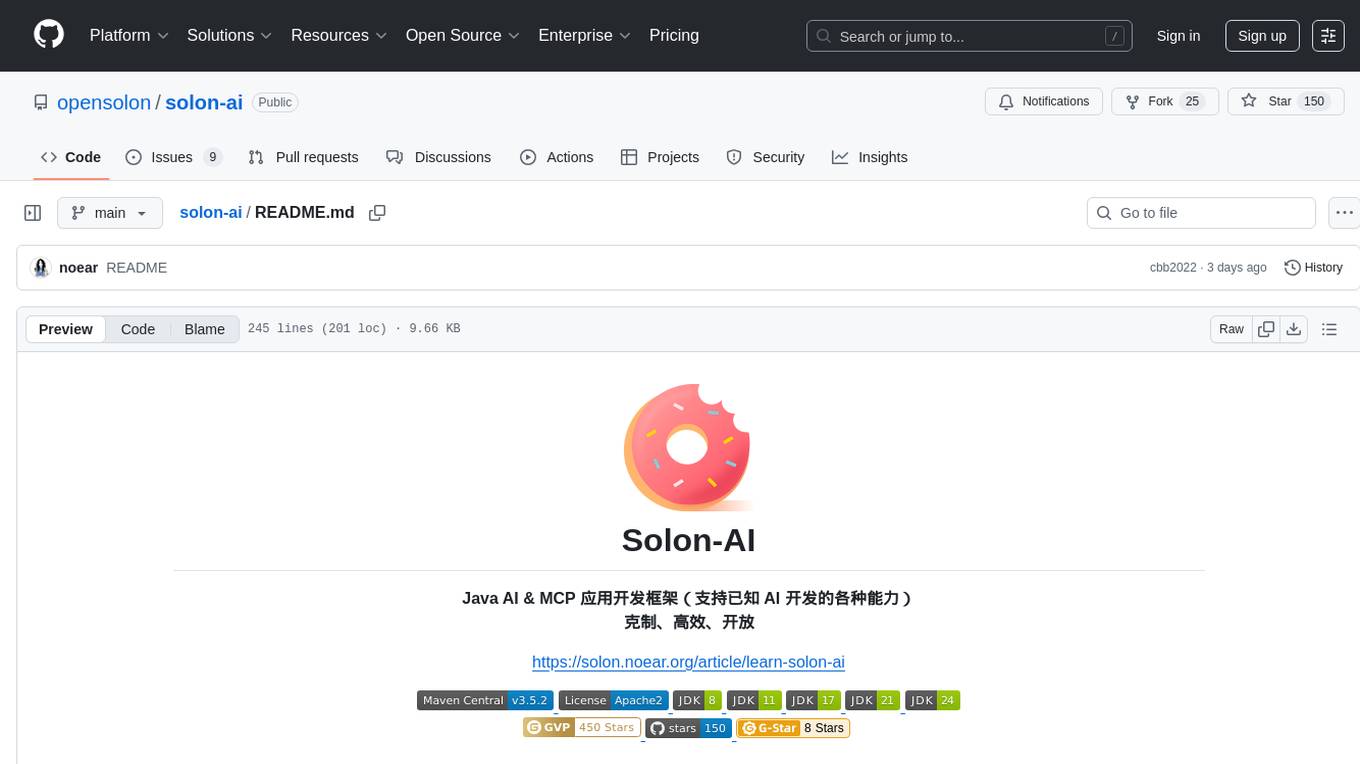
Solon-AI is a Java AI & MCP application development framework that supports various AI development capabilities. It is designed to be versatile, efficient, and open for integration with frameworks like SpringBoot, jFinal, and Vert.x. The framework provides examples of embedding solon-ai(& mcp) and showcases interfaces for chat models, function calling, vision, RAG (EmbeddingModel, Repository, DocumentLoader, RerankingModel), Ai Flow, MCP server, MCP client, and MCP Proxy. Solon-AI is part of the Solon project ecosystem, which includes other repositories for different functionalities.
README:
Java AI & MCP 应用开发框架(支持已知 AI 开发的各种能力)
克制、高效、开放
https://solon.noear.org/article/learn-solon-ai
面向全场景的 Java AI 应用开发框架(支持已知 AI 开发的各种能力)。是 Solon 项目的一部分。也可嵌入到 SpringBoot、jFinal、Vert.x 等框架中使用。
其中 solon-ai(& mcp) 的嵌入示例:
- https://gitee.com/solonlab/solon-ai-mcp-embedded-examples
- https://gitcode.com/solonlab/solon-ai-mcp-embedded-examples
- https://github.com/solonlab/solon-ai-mcp-embedded-examples
- ChatModel(通用接口,基于方言适配实现不同提供商与模型的扩展)
ChatModel chatModel = ChatModel.of("http://127.0.0.1:11434/api/chat")
.provider("ollama") //需要指定供应商,用于识别接口风格(也称为方言)
.model("qwen2.5:1.5b")
.build();
//同步调用,并打印响应消息
System.out.println(chatModel.prompt("hello").call().getMessage());
//响应式调用
chatModel.prompt("hello").stream(); //Publisher<ChatResponse>- Function Calling(或者 Tool Calling)
//可以添加默认工具(即所有请求有产),或请求时工具
chatModel.prompt("今天杭州的天气情况?")
.options(op->op.toolsAdd(new FunctionTools()))
.call();- Vision(多媒体感知)
chatModel.prompt(ChatMessage.ofUser("这图里有方块吗?", Image.ofUrl(imageUrl)))
.call();- RAG(EmbeddingModel,Repository,DocumentLoader,RerankingModel)
//构建知识库
EmbeddingModel embeddingModel = EmbeddingModel.of(apiUrl).apiKey(apiKey).provider(provider).model(model).batchSize(10).build();
RerankingModel rerankingModel = RerankingModel.of(apiUrl).apiKey(apiKey).provider(provider).model(model).build();
InMemoryRepository repository = new InMemoryRepository(TestUtils.getEmbeddingModel()); //3.初始化知识库
repository.insert(new PdfLoader(pdfUri).load());
//检索
List<Document> docs = repository.search(query);
//如果有需要,可以重排一下
docs = rerankingModel.rerank(query, docs);
//提示语增强是
ChatMessage message = ChatMessage.augment(query, docs);
//调用大模型
chatModel.prompt(message)
.call();- Ai Flow(模拟实现 Dify 的流程应用)
id: demo1
layout:
- type: "start"
- task: "@VarInput"
meta:
message: "Solon 是谁开发的?"
- task: "@EmbeddingModel"
meta:
embeddingConfig: # "@type": "org.noear.solon.ai.embedding.EmbeddingConfig"
provider: "ollama"
model: "bge-m3"
apiUrl: "http://127.0.0.1:11434/api/embed"
- task: "@InMemoryRepository"
meta:
documentSources:
- "https://solon.noear.org/article/about?format=md"
splitPipeline:
- "org.noear.solon.ai.rag.splitter.RegexTextSplitter"
- "org.noear.solon.ai.rag.splitter.TokenSizeTextSplitter"
- task: "@ChatModel"
meta:
systemPrompt: "你是个知识库"
stream: false
chatConfig: # "@type": "org.noear.solon.ai.chat.ChatConfig"
provider: "ollama"
model: "qwen2.5:1.5b"
apiUrl: "http://127.0.0.1:11434/api/chat"
- task: "@ConsoleOutput"
# FlowEngine flowEngine = FlowEngine.newInstance();
# ...
# flowEngine.eval("demo1");- MCP server(支持多端点)
//组件方式构建
@McpServerEndpoint(name="mcp-case1", sseEndpoint = "/case1/sse")
public class McpServer {
@ToolMapping(description = "查询天气预报")
public String getWeather(@Param(description = "城市位置") String location) {
return "晴,14度";
}
@ResourceMapping(uri = "config://app-version", description = "获取应用版本号", mimeType = "text/config")
public String getAppVersion() {
return "v3.2.0";
}
@PromptMapping(description = "生成关于某个主题的提问")
public Collection<ChatMessage> askQuestion(@Param(description = "主题") String topic) {
return Arrays.asList(
ChatMessage.ofUser("请解释一下'" + topic + "'的概念?")
);
}
}
//原生 java 方式构建
McpServerEndpointProvider serverEndpoint = McpServerEndpointProvider.builder()
.name("mcp-case2")
.sseEndpoint("/case2/sse")
.build();
serverEndpoint.addTool(new MethodToolProvider(new McpServerTools())); //添加工具
serverEndpoint.addResource(new MethodResourceProvider(new McpServerResources())); //添加资源
serverEndpoint.addPrompt(new MethodPromptProvider(new McpServerPrompts())); //添加提示语
serverEndpoint.postStart();- MCP client
McpClientToolProvider clientToolProvider = McpClientToolProvider.builder()
.apiUrl("http://localhost:8080/case1/sse")
.build();
String rst = clientToolProvider.callToolAsText("getWeather", Map.of("location", "杭州"))
.getContent();- MCP Proxy (示例,把 gitee mcp stdio 转为 sse 服务)
配置参考自:https://gitee.com/oschina/mcp-gitee
@McpServerEndpoint(name = "mcp-case3", sseEndpoint="/case3/sse")
public class McpStdioToSseServerDemo implements ToolProvider {
McpClientProvider stdioToolProvider = McpClientProvider.builder()
.channel(McpChannel.STDIO) //表示使用 stdio
.command("npx")
.args("-y", "@gitee/mcp-gitee@latest")
.addEnvVar("GITEE_API_BASE", "https://gitee.com/api/v5")
.addEnvVar("GITEE_ACCESS_TOKEN", "<your personal access token>")
.build();
@Override
public Collection<FunctionTool> getTools() {
return stdioToolProvider.getTools();
}
}| 代码仓库 | 描述 |
|---|---|
| /opensolon/solon | Solon ,主代码仓库 |
| /opensolon/solon-examples | Solon ,官网配套示例代码仓库 |
| /opensolon/solon-expression | Solon Expression ,代码仓库 |
| /opensolon/solon-flow | Solon Flow ,代码仓库 |
| /opensolon/solon-ai | Solon Ai ,代码仓库 |
| /opensolon/solon-cloud | Solon Cloud ,代码仓库 |
| /opensolon/solon-admin | Solon Admin ,代码仓库 |
| /opensolon/solon-jakarta | Solon Jakarta ,代码仓库(base java21) |
| /opensolon/solon-integration | Solon Integration ,代码仓库 |
| /opensolon/solon-gradle-plugin | Solon Gradle ,插件代码仓库 |
| /opensolon/solon-idea-plugin | Solon Idea ,插件代码仓库 |
| /opensolon/solon-vscode-plugin | Solon VsCode ,插件代码仓库 |
For Tasks:
Click tags to check more tools for each tasksFor Jobs:
Alternative AI tools for solon-ai
Similar Open Source Tools

solon-ai
Solon-AI is a Java AI & MCP application development framework that supports various AI development capabilities. It is designed to be versatile, efficient, and open for integration with frameworks like SpringBoot, jFinal, and Vert.x. The framework provides examples of embedding solon-ai(& mcp) and showcases interfaces for chat models, function calling, vision, RAG (EmbeddingModel, Repository, DocumentLoader, RerankingModel), Ai Flow, MCP server, MCP client, and MCP Proxy. Solon-AI is part of the Solon project ecosystem, which includes other repositories for different functionalities.
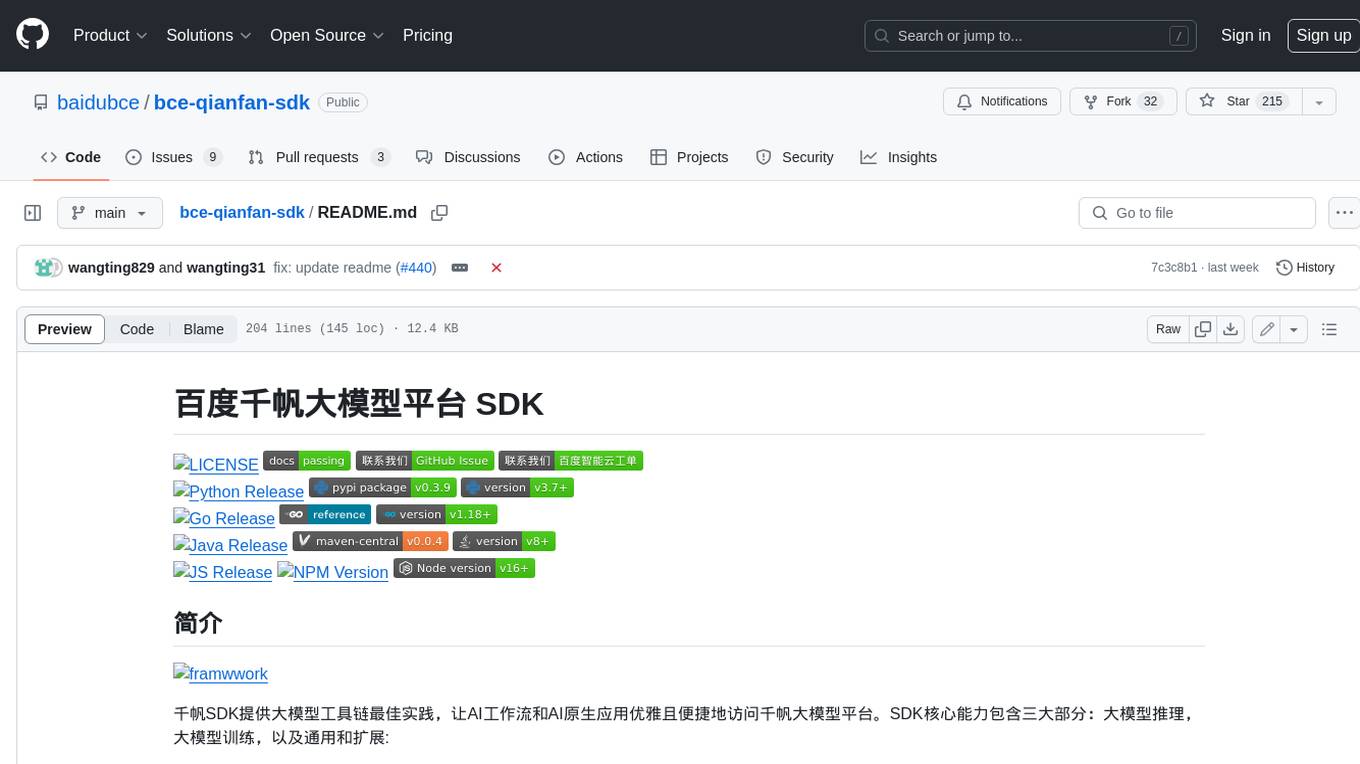
bce-qianfan-sdk
The Qianfan SDK provides best practices for large model toolchains, allowing AI workflows and AI-native applications to access the Qianfan large model platform elegantly and conveniently. The core capabilities of the SDK include three parts: large model reasoning, large model training, and general and extension: * `Large model reasoning`: Implements interface encapsulation for reasoning of Yuyan (ERNIE-Bot) series, open source large models, etc., supporting dialogue, completion, Embedding, etc. * `Large model training`: Based on platform capabilities, it supports end-to-end large model training process, including training data, fine-tuning/pre-training, and model services. * `General and extension`: General capabilities include common AI development tools such as Prompt/Debug/Client. The extension capability is based on the characteristics of Qianfan to adapt to common middleware frameworks.
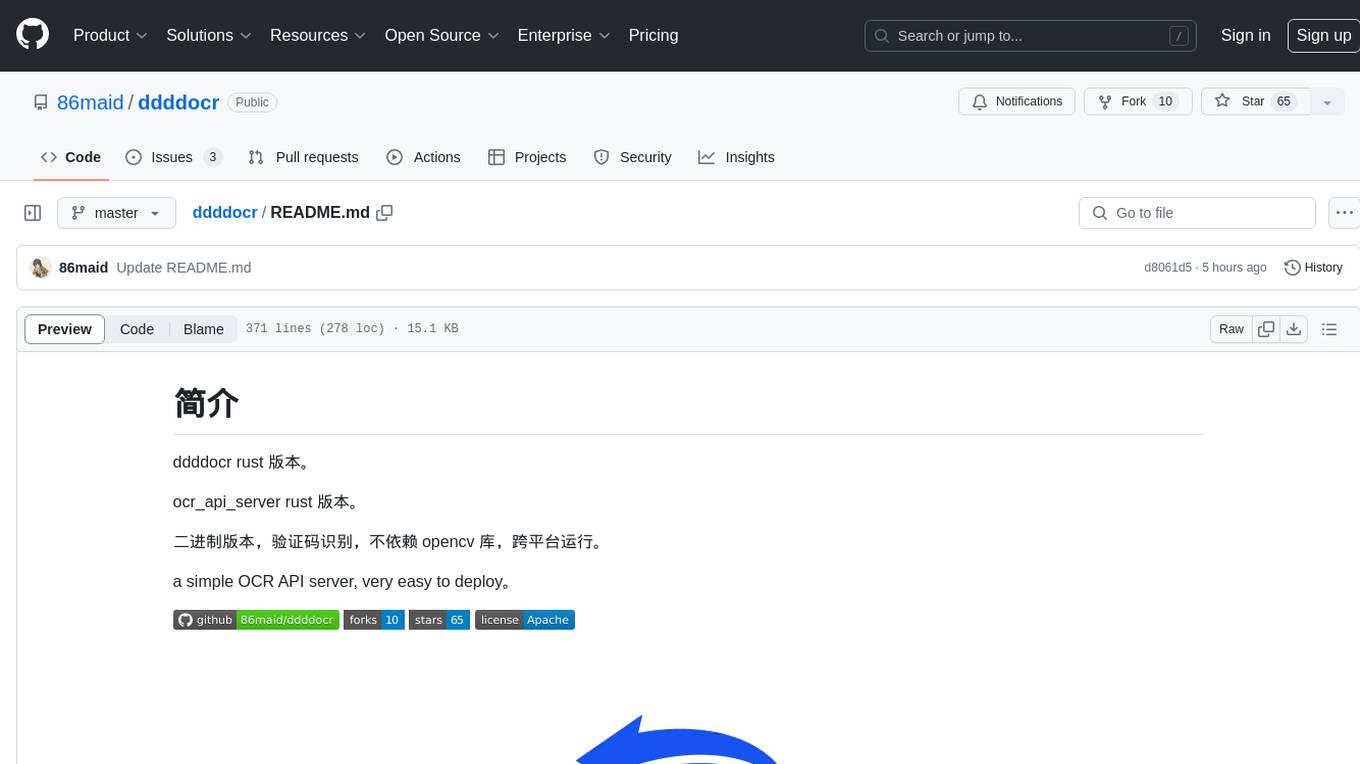
ddddocr
ddddocr is a Rust version of a simple OCR API server that provides easy deployment for captcha recognition without relying on the OpenCV library. It offers a user-friendly general-purpose captcha recognition Rust library. The tool supports recognizing various types of captchas, including single-line text, transparent black PNG images, target detection, and slider matching algorithms. Users can also import custom OCR training models and utilize the OCR API server for flexible OCR result control and range limitation. The tool is cross-platform and can be easily deployed.
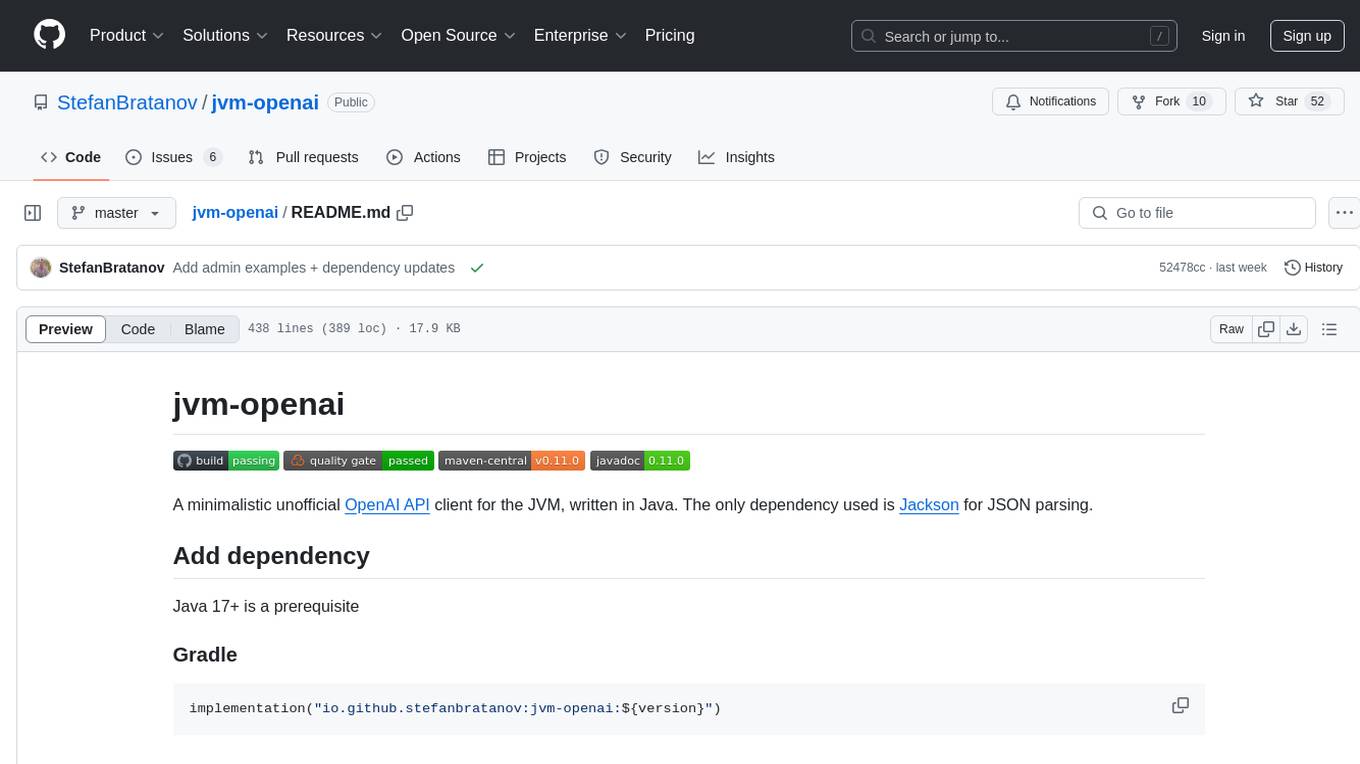
jvm-openai
jvm-openai is a minimalistic unofficial OpenAI API client for the JVM, written in Java. It serves as a Java client for OpenAI API with a focus on simplicity and minimal dependencies. The tool provides support for various OpenAI APIs and endpoints, including Audio, Chat, Embeddings, Fine-tuning, Batch, Files, Uploads, Images, Models, Moderations, Assistants, Threads, Messages, Runs, Run Steps, Vector Stores, Vector Store Files, Vector Store File Batches, Invites, Users, Projects, Project Users, Project Service Accounts, Project API Keys, and Audit Logs. Users can easily integrate this tool into their Java projects to interact with OpenAI services efficiently.
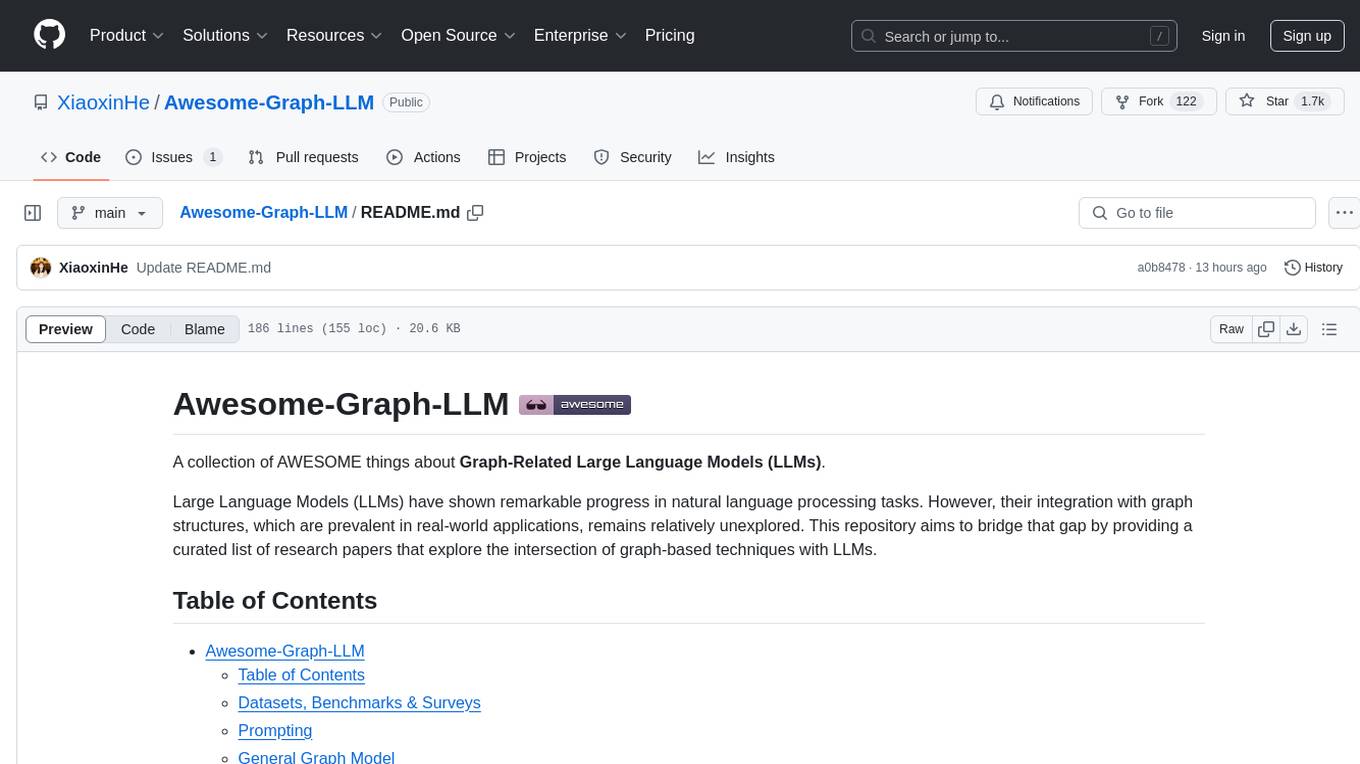
Awesome-Graph-LLM
Awesome-Graph-LLM is a curated collection of research papers exploring the intersection of graph-based techniques with Large Language Models (LLMs). The repository aims to bridge the gap between LLMs and graph structures prevalent in real-world applications by providing a comprehensive list of papers covering various aspects of graph reasoning, node classification, graph classification/regression, knowledge graphs, multimodal models, applications, and tools. It serves as a valuable resource for researchers and practitioners interested in leveraging LLMs for graph-related tasks.
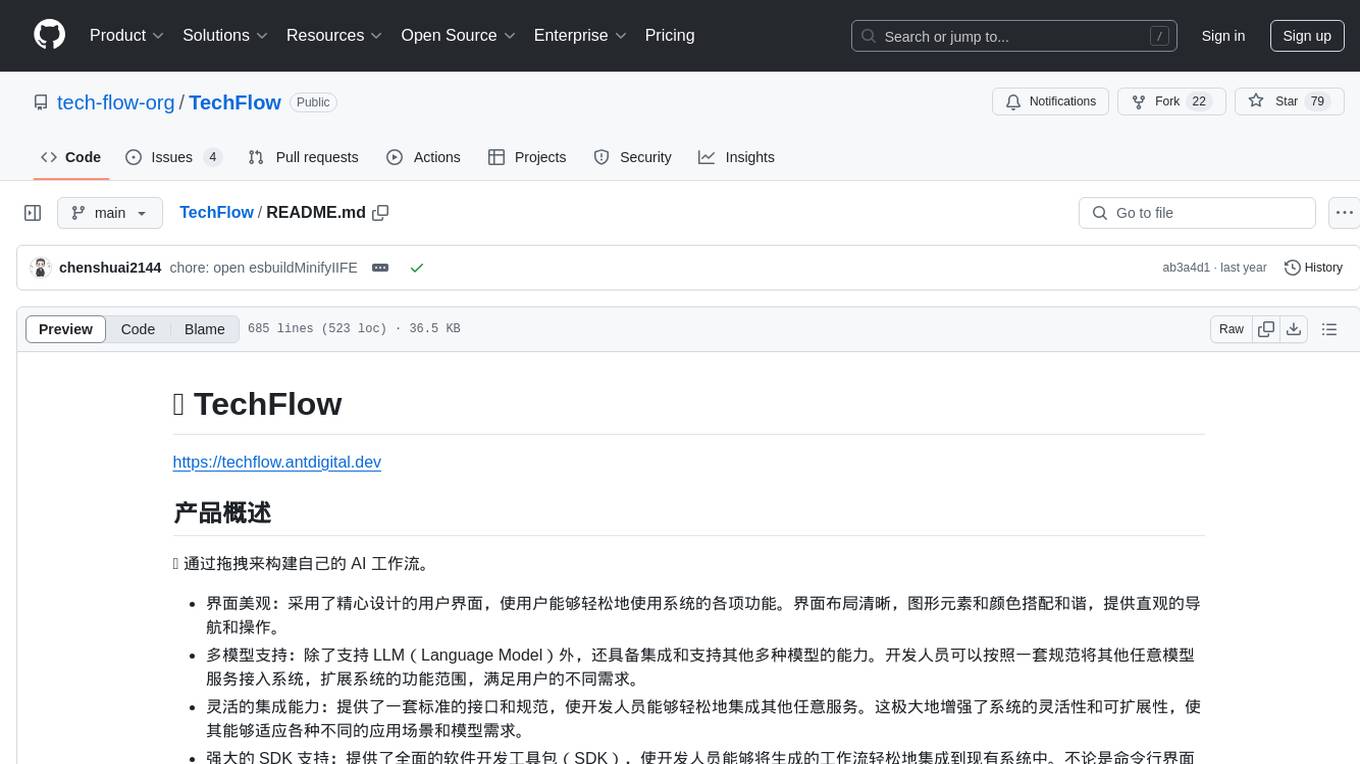
TechFlow
TechFlow is a platform that allows users to build their own AI workflows through drag-and-drop functionality. It features a visually appealing interface with clear layout and intuitive navigation. TechFlow supports multiple models beyond Language Models (LLM) and offers flexible integration capabilities. It provides a powerful SDK for developers to easily integrate generated workflows into existing systems, enhancing flexibility and scalability. The platform aims to embed AI capabilities as modules into existing functionalities to enhance business competitiveness.
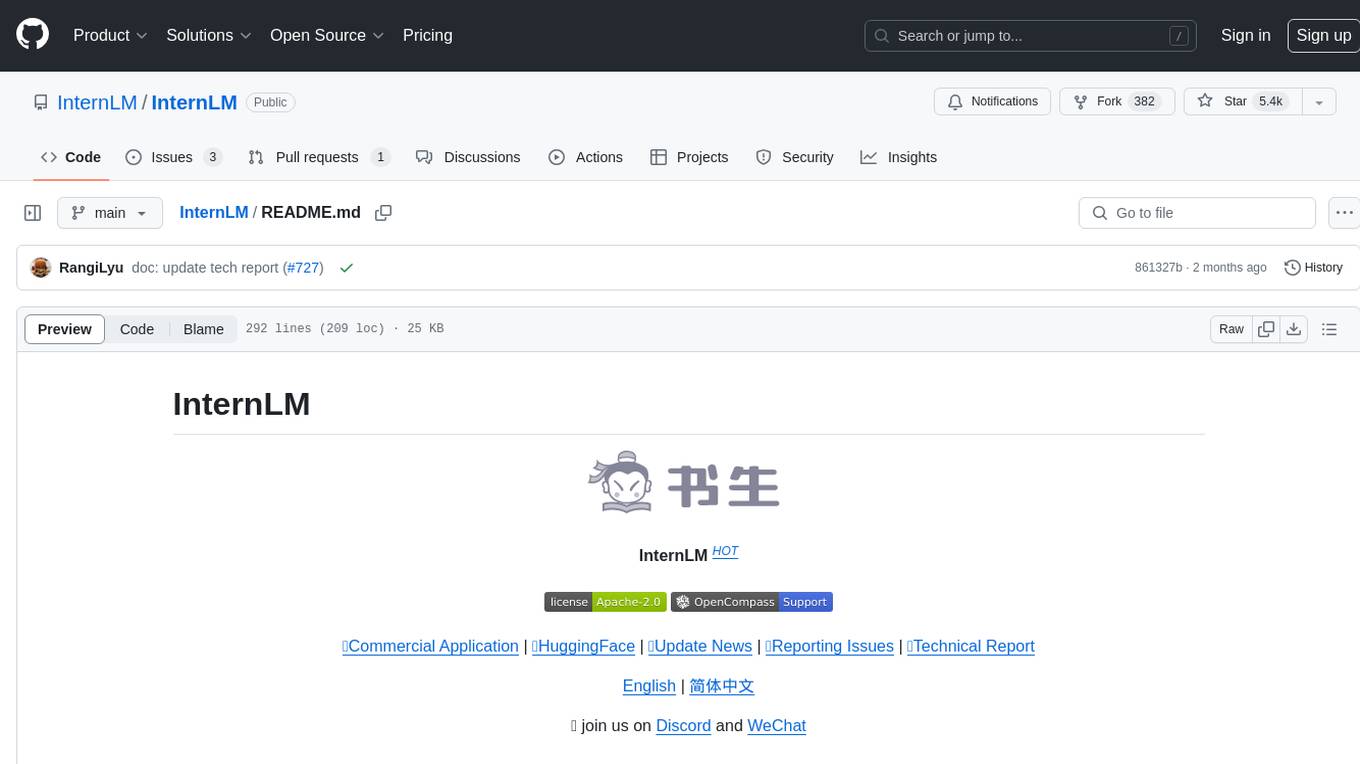
InternLM
InternLM is a powerful language model series with features such as 200K context window for long-context tasks, outstanding comprehensive performance in reasoning, math, code, chat experience, instruction following, and creative writing, code interpreter & data analysis capabilities, and stronger tool utilization capabilities. It offers models in sizes of 7B and 20B, suitable for research and complex scenarios. The models are recommended for various applications and exhibit better performance than previous generations. InternLM models may match or surpass other open-source models like ChatGPT. The tool has been evaluated on various datasets and has shown superior performance in multiple tasks. It requires Python >= 3.8, PyTorch >= 1.12.0, and Transformers >= 4.34 for usage. InternLM can be used for tasks like chat, agent applications, fine-tuning, deployment, and long-context inference.
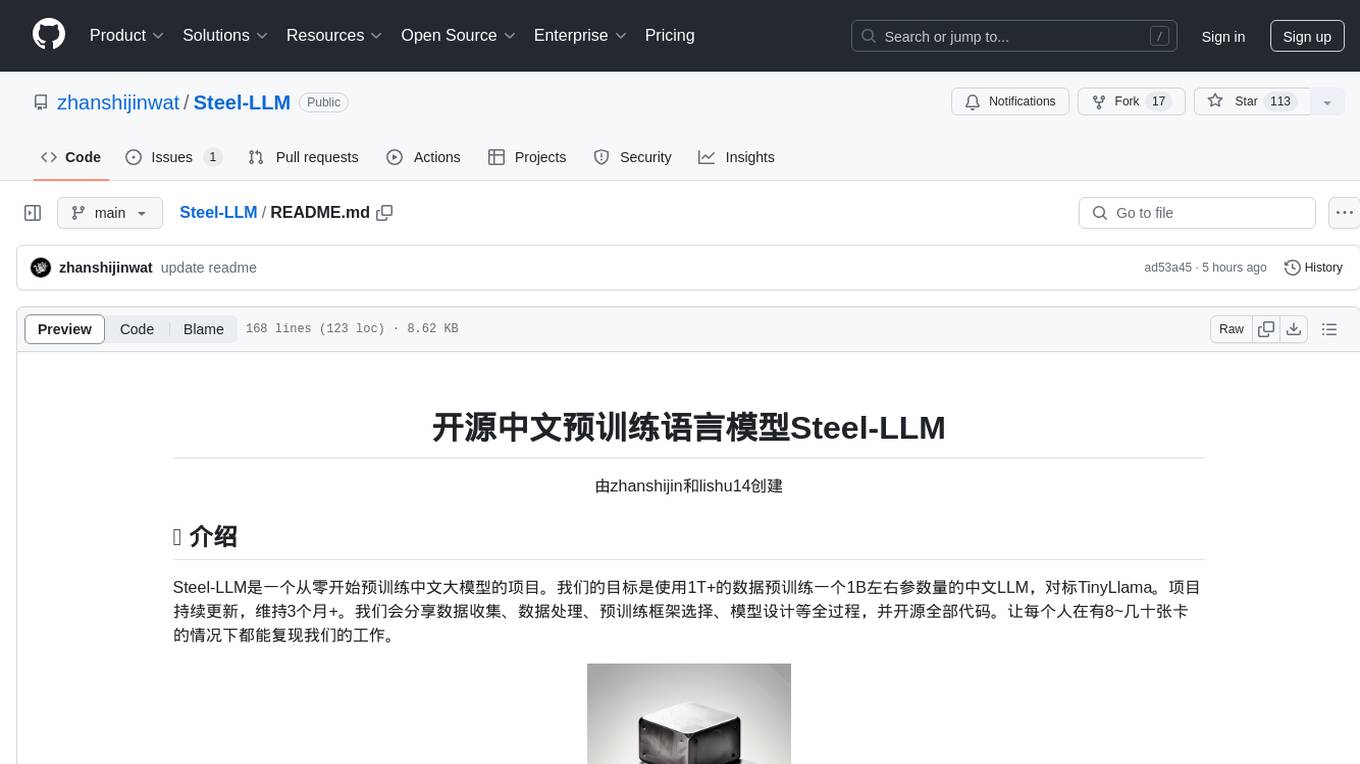
Steel-LLM
Steel-LLM is a project to pre-train a large Chinese language model from scratch using over 1T of data to achieve a parameter size of around 1B, similar to TinyLlama. The project aims to share the entire process including data collection, data processing, pre-training framework selection, model design, and open-source all the code. The goal is to enable reproducibility of the work even with limited resources. The name 'Steel' is inspired by a band '万能青年旅店' and signifies the desire to create a strong model despite limited conditions. The project involves continuous data collection of various cultural elements, trivia, lyrics, niche literature, and personal secrets to train the LLM. The ultimate aim is to fill the model with diverse data and leave room for individual input, fostering collaboration among users.
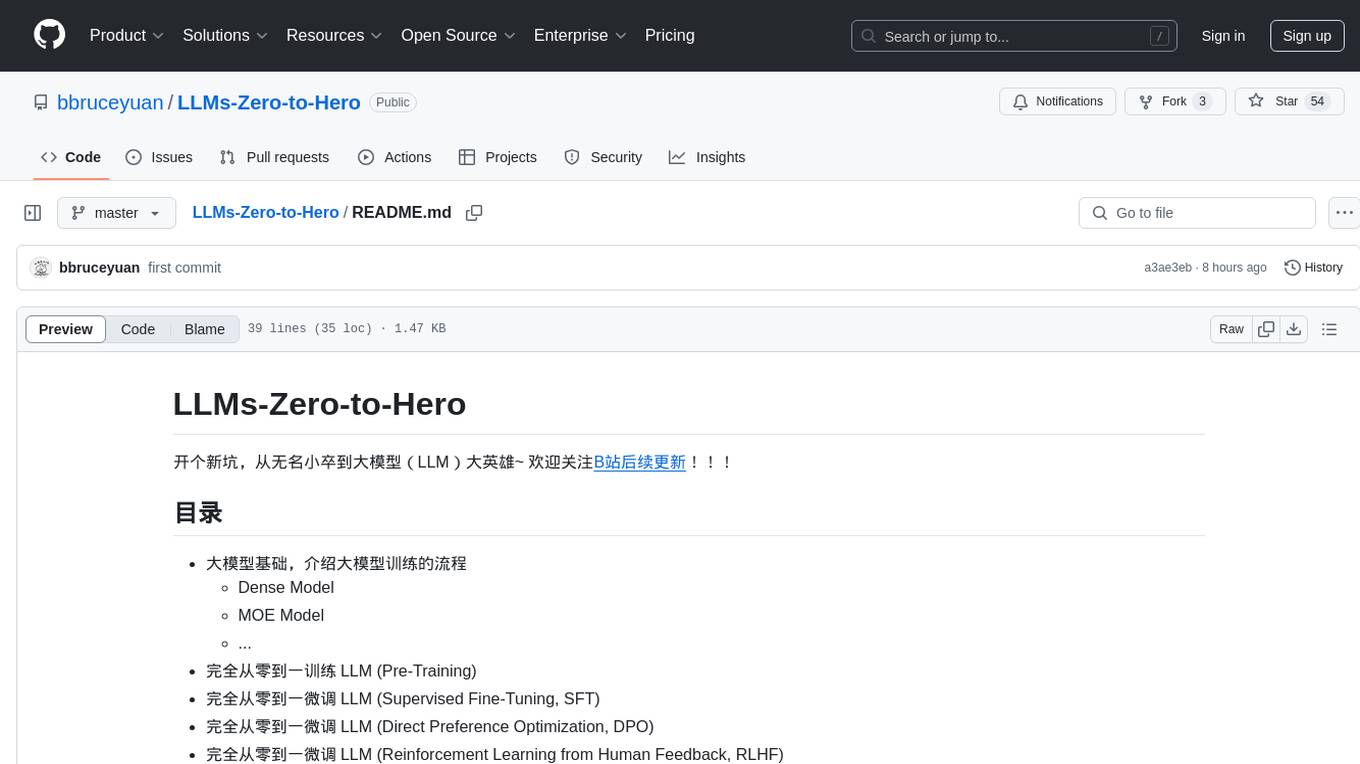
LLMs-Zero-to-Hero
LLMs-Zero-to-Hero is a repository dedicated to training large language models (LLMs) from scratch, covering topics such as dense models, MOE models, pre-training, supervised fine-tuning, direct preference optimization, reinforcement learning from human feedback, and deploying large models. The repository provides detailed learning notes for different chapters, code implementations, and resources for training and deploying LLMs. It aims to guide users from being beginners to proficient in building and deploying large language models.
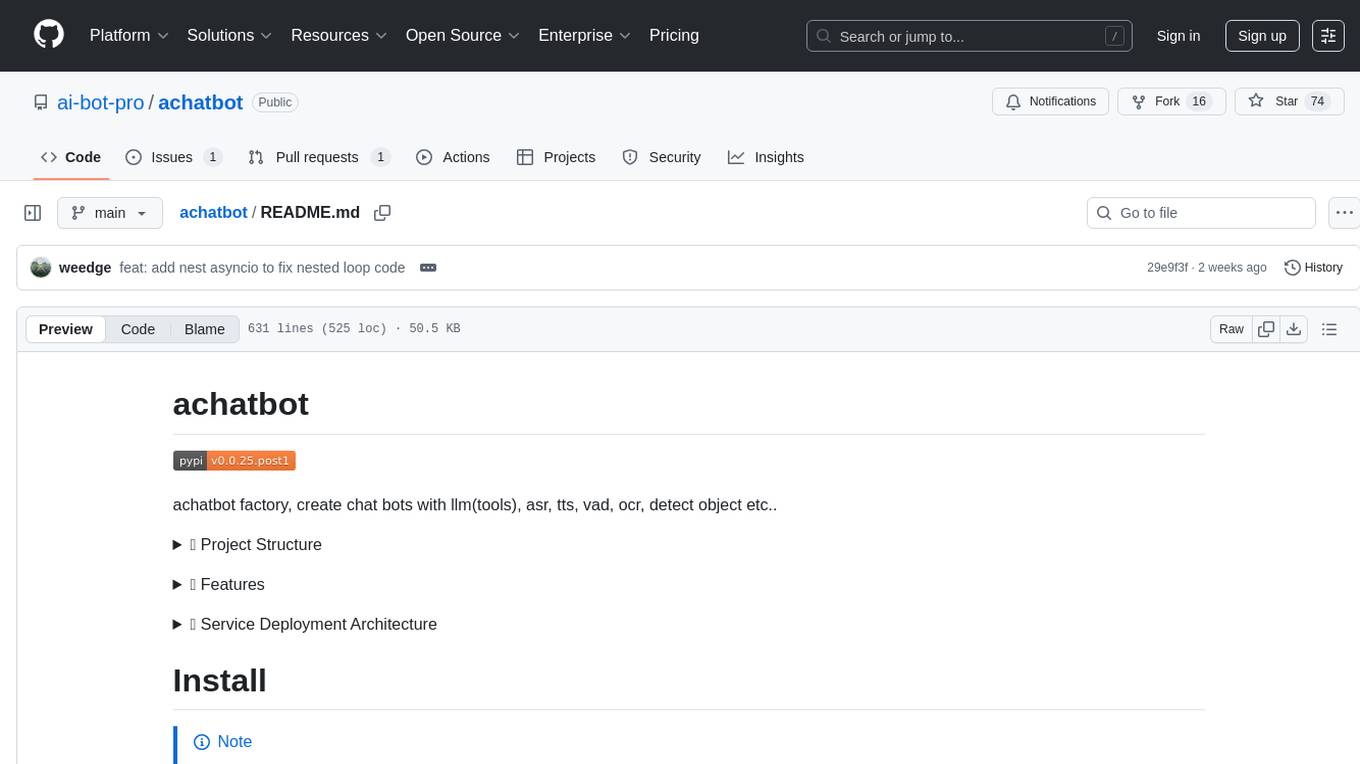
achatbot
achatbot is a factory tool that allows users to create chat bots with various functionalities such as llm (language models), asr (automatic speech recognition), tts (text-to-speech), vad (voice activity detection), ocr (optical character recognition), and object detection. The tool provides a structured project with features like chat bots for cmd, grpc, and http servers. It supports various chat bot processors, transport connectors, and AI modules for different tasks. Users can run chat bots locally or deploy them on cloud services like vercel, Cloudflare, AWS Lambda, or Docker. The tool also includes UI components for easy deployment and service architecture diagrams for reference.
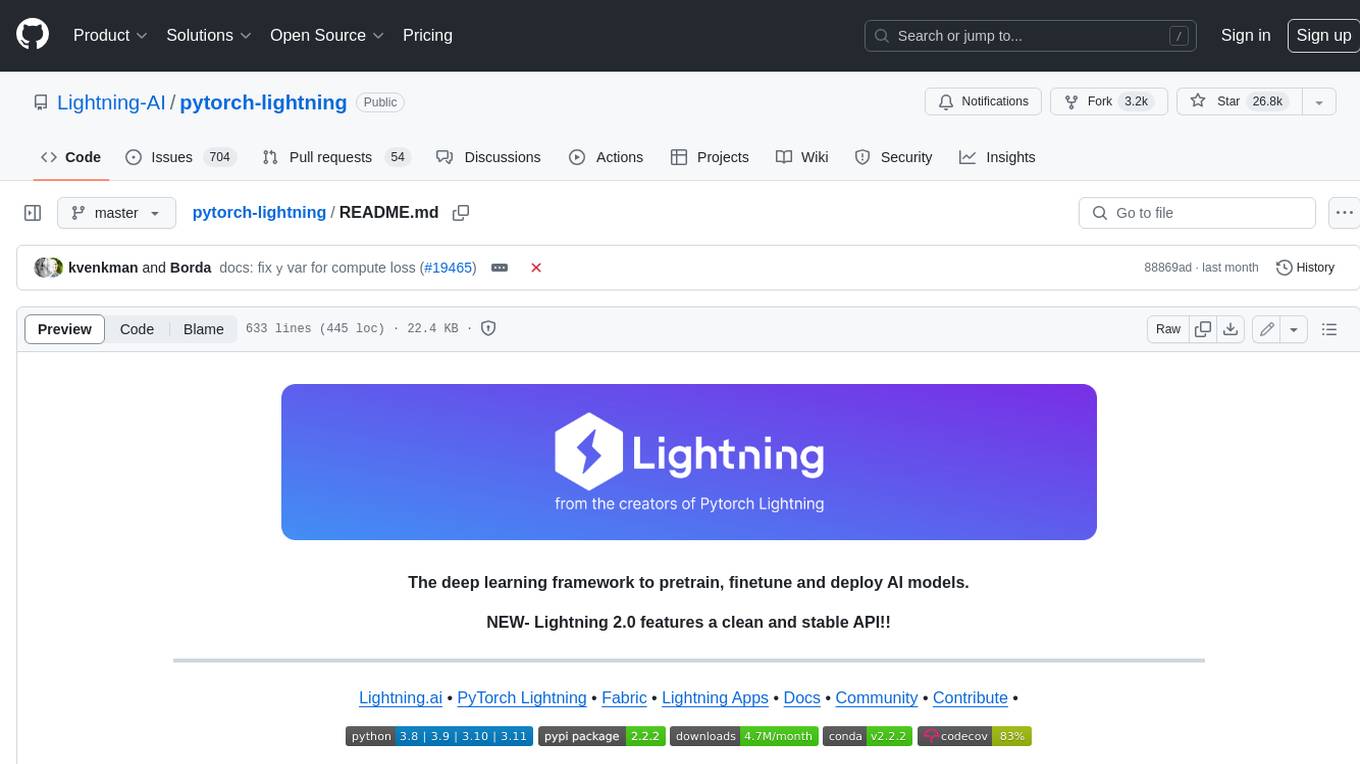
pytorch-lightning
PyTorch Lightning is a framework for training and deploying AI models. It provides a high-level API that abstracts away the low-level details of PyTorch, making it easier to write and maintain complex models. Lightning also includes a number of features that make it easy to train and deploy models on multiple GPUs or TPUs, and to track and visualize training progress. PyTorch Lightning is used by a wide range of organizations, including Google, Facebook, and Microsoft. It is also used by researchers at top universities around the world. Here are some of the benefits of using PyTorch Lightning: * **Increased productivity:** Lightning's high-level API makes it easy to write and maintain complex models. This can save you time and effort, and allow you to focus on the research or business problem you're trying to solve. * **Improved performance:** Lightning's optimized training loops and data loading pipelines can help you train models faster and with better performance. * **Easier deployment:** Lightning makes it easy to deploy models to a variety of platforms, including the cloud, on-premises servers, and mobile devices. * **Better reproducibility:** Lightning's logging and visualization tools make it easy to track and reproduce training results.
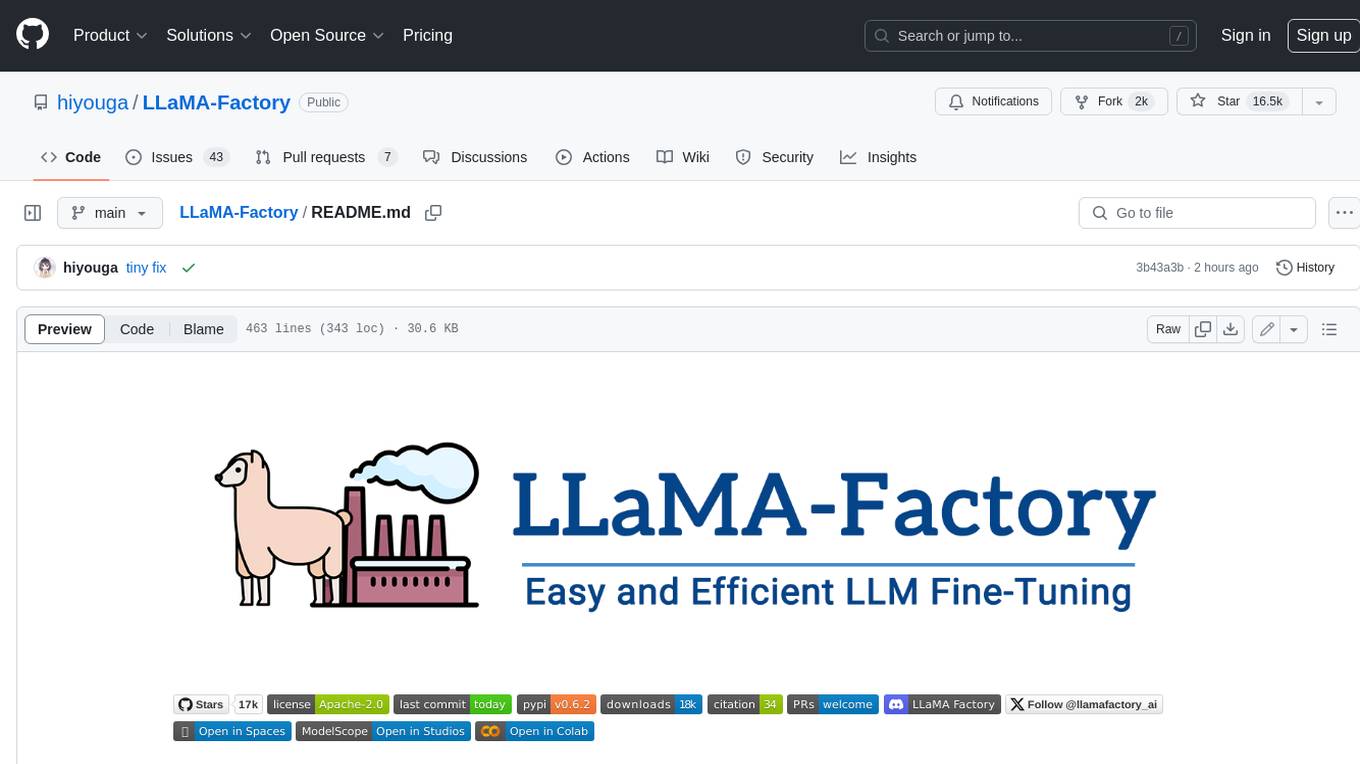
LLaMA-Factory
LLaMA Factory is a unified framework for fine-tuning 100+ large language models (LLMs) with various methods, including pre-training, supervised fine-tuning, reward modeling, PPO, DPO and ORPO. It features integrated algorithms like GaLore, BAdam, DoRA, LongLoRA, LLaMA Pro, LoRA+, LoftQ and Agent tuning, as well as practical tricks like FlashAttention-2, Unsloth, RoPE scaling, NEFTune and rsLoRA. LLaMA Factory provides experiment monitors like LlamaBoard, TensorBoard, Wandb, MLflow, etc., and supports faster inference with OpenAI-style API, Gradio UI and CLI with vLLM worker. Compared to ChatGLM's P-Tuning, LLaMA Factory's LoRA tuning offers up to 3.7 times faster training speed with a better Rouge score on the advertising text generation task. By leveraging 4-bit quantization technique, LLaMA Factory's QLoRA further improves the efficiency regarding the GPU memory.
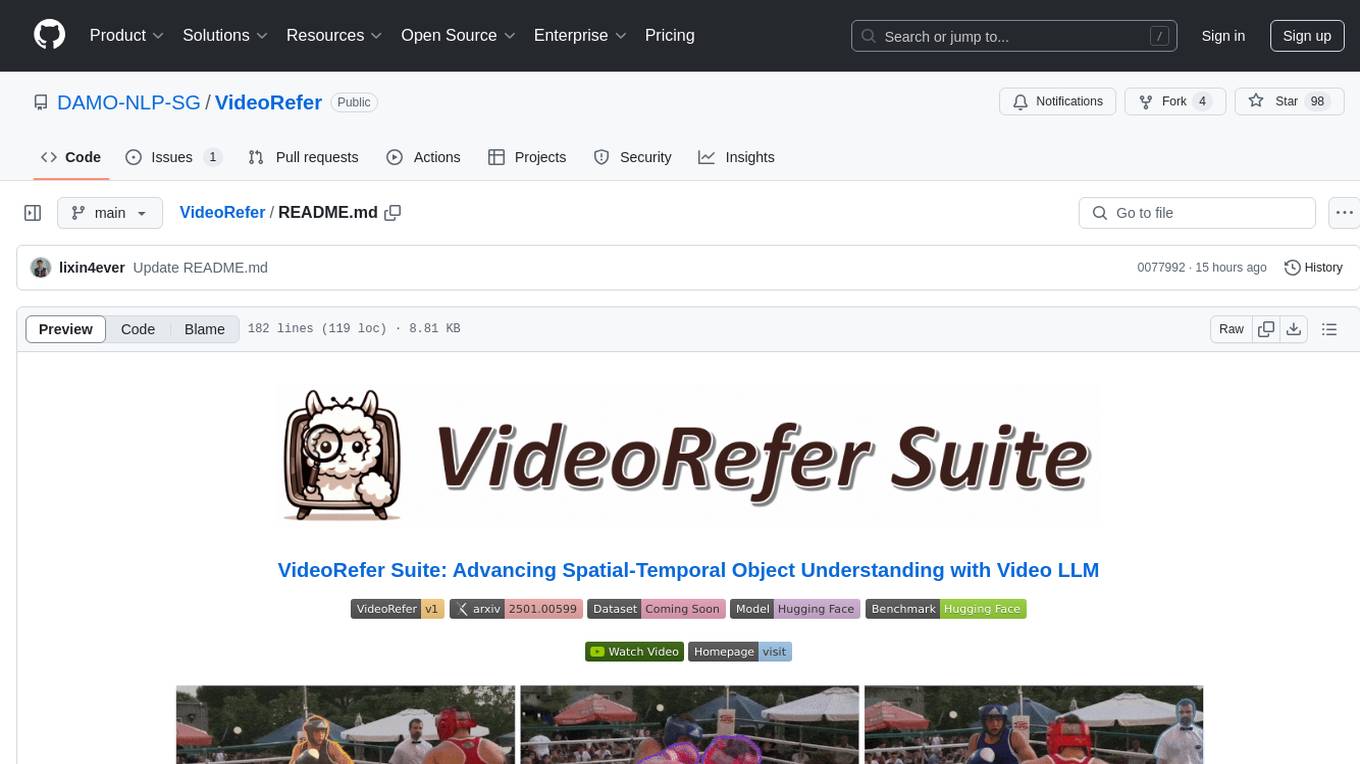
VideoRefer
VideoRefer Suite is a tool designed to enhance the fine-grained spatial-temporal understanding capabilities of Video Large Language Models (Video LLMs). It consists of three primary components: Model (VideoRefer) for perceiving, reasoning, and retrieval for user-defined regions at any specified timestamps, Dataset (VideoRefer-700K) for high-quality object-level video instruction data, and Benchmark (VideoRefer-Bench) to evaluate object-level video understanding capabilities. The tool can understand any object within a video.
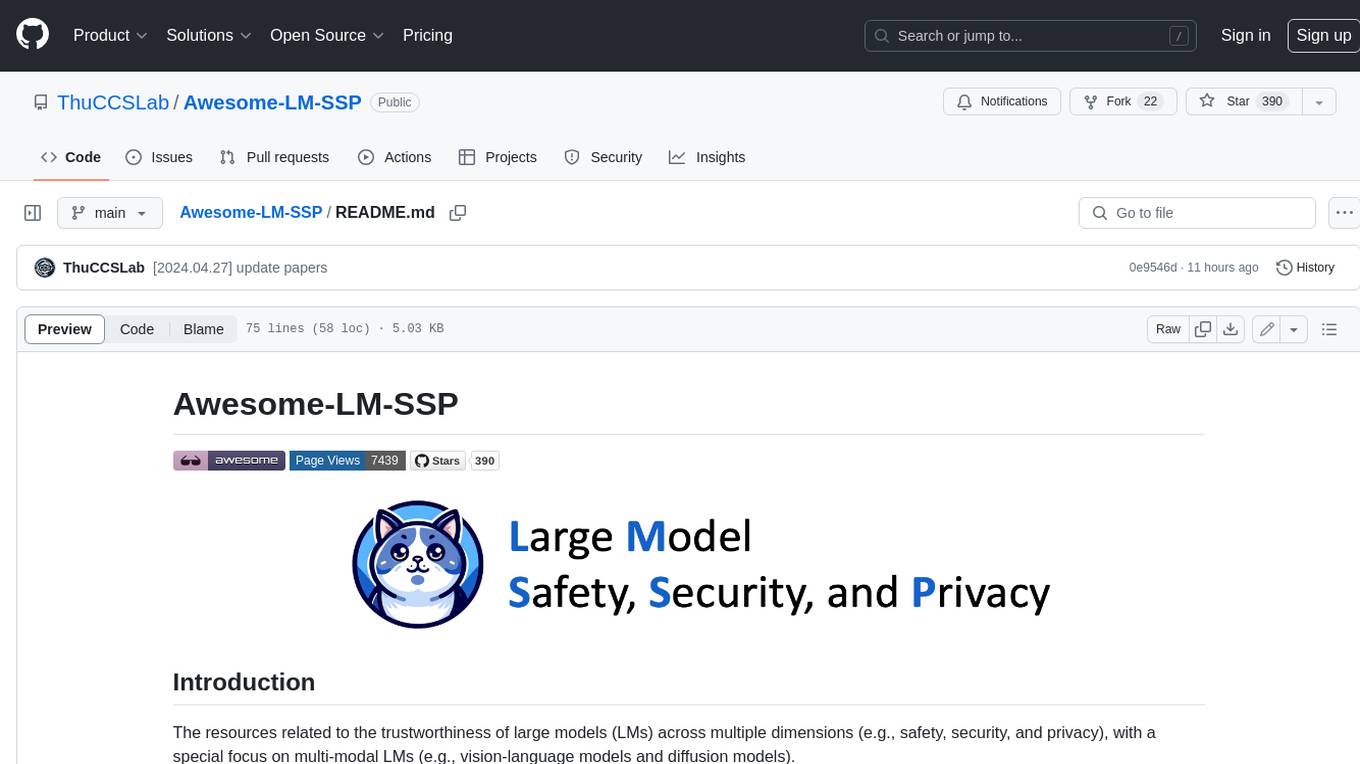
Awesome-LM-SSP
The Awesome-LM-SSP repository is a collection of resources related to the trustworthiness of large models (LMs) across multiple dimensions, with a special focus on multi-modal LMs. It includes papers, surveys, toolkits, competitions, and leaderboards. The resources are categorized into three main dimensions: safety, security, and privacy. Within each dimension, there are several subcategories. For example, the safety dimension includes subcategories such as jailbreak, alignment, deepfake, ethics, fairness, hallucination, prompt injection, and toxicity. The security dimension includes subcategories such as adversarial examples, poisoning, and system security. The privacy dimension includes subcategories such as contamination, copyright, data reconstruction, membership inference attacks, model extraction, privacy-preserving computation, and unlearning.
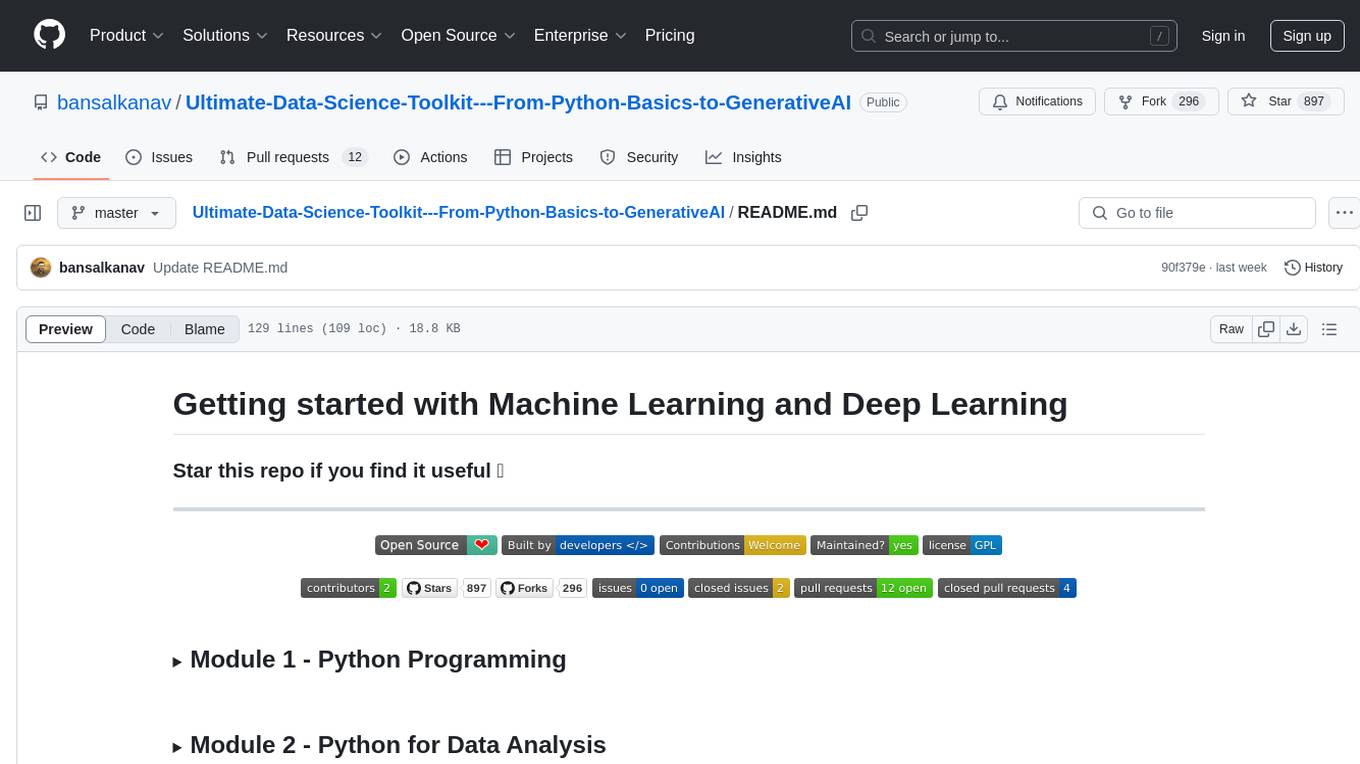
Ultimate-Data-Science-Toolkit---From-Python-Basics-to-GenerativeAI
Ultimate Data Science Toolkit is a comprehensive repository covering Python basics to Generative AI. It includes modules on Python programming, data analysis, statistics, machine learning, MLOps, case studies, and deep learning. The repository provides detailed tutorials on various topics such as Python data structures, control statements, functions, modules, object-oriented programming, exception handling, file handling, web API, databases, list comprehension, lambda functions, Pandas, Numpy, data visualization, statistical analysis, supervised and unsupervised machine learning algorithms, model serialization, ML pipeline orchestration, case studies, and deep learning concepts like neural networks and autoencoders.
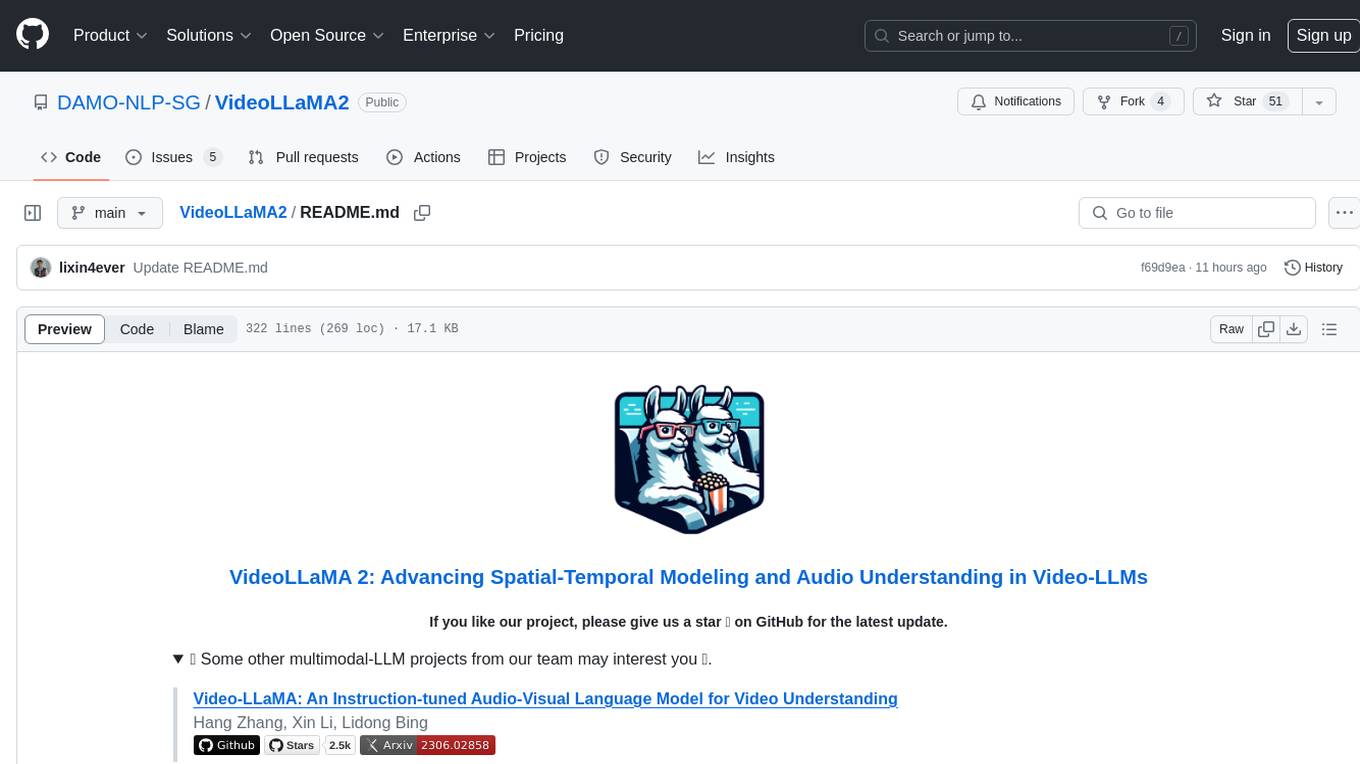
VideoLLaMA2
VideoLLaMA 2 is a project focused on advancing spatial-temporal modeling and audio understanding in video-LLMs. It provides tools for multi-choice video QA, open-ended video QA, and video captioning. The project offers model zoo with different configurations for visual encoder and language decoder. It includes training and evaluation guides, as well as inference capabilities for video and image processing. The project also features a demo setup for running a video-based Large Language Model web demonstration.
For similar tasks

solon-ai
Solon-AI is a Java AI & MCP application development framework that supports various AI development capabilities. It is designed to be versatile, efficient, and open for integration with frameworks like SpringBoot, jFinal, and Vert.x. The framework provides examples of embedding solon-ai(& mcp) and showcases interfaces for chat models, function calling, vision, RAG (EmbeddingModel, Repository, DocumentLoader, RerankingModel), Ai Flow, MCP server, MCP client, and MCP Proxy. Solon-AI is part of the Solon project ecosystem, which includes other repositories for different functionalities.
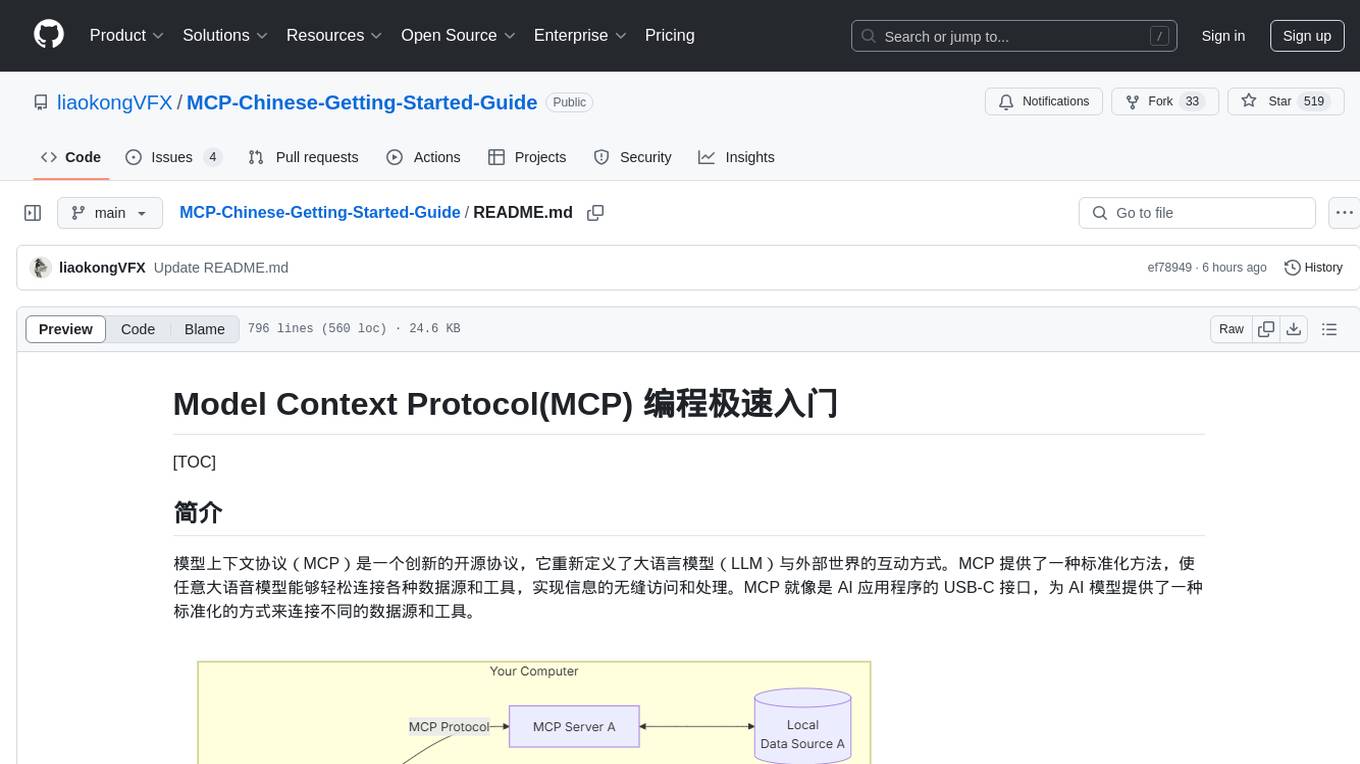
MCP-Chinese-Getting-Started-Guide
The Model Context Protocol (MCP) is an innovative open-source protocol that redefines the interaction between large language models (LLMs) and the external world. MCP provides a standardized approach for any large language model to easily connect to various data sources and tools, enabling seamless access and processing of information. MCP acts as a USB-C interface for AI applications, offering a standardized way for AI models to connect to different data sources and tools. The core functionalities of MCP include Resources, Prompts, Tools, Sampling, Roots, and Transports. This guide focuses on developing an MCP server for network search using Python and uv management. It covers initializing the project, installing dependencies, creating a server, implementing tool execution methods, and running the server. Additionally, it explains how to debug the MCP server using the Inspector tool, how to call tools from the server, and how to connect multiple MCP servers. The guide also introduces the Sampling feature, which allows pre- and post-tool execution operations, and demonstrates how to integrate MCP servers into LangChain for AI applications.
For similar jobs

sweep
Sweep is an AI junior developer that turns bugs and feature requests into code changes. It automatically handles developer experience improvements like adding type hints and improving test coverage.

teams-ai
The Teams AI Library is a software development kit (SDK) that helps developers create bots that can interact with Teams and Microsoft 365 applications. It is built on top of the Bot Framework SDK and simplifies the process of developing bots that interact with Teams' artificial intelligence capabilities. The SDK is available for JavaScript/TypeScript, .NET, and Python.

ai-guide
This guide is dedicated to Large Language Models (LLMs) that you can run on your home computer. It assumes your PC is a lower-end, non-gaming setup.

classifai
Supercharge WordPress Content Workflows and Engagement with Artificial Intelligence. Tap into leading cloud-based services like OpenAI, Microsoft Azure AI, Google Gemini and IBM Watson to augment your WordPress-powered websites. Publish content faster while improving SEO performance and increasing audience engagement. ClassifAI integrates Artificial Intelligence and Machine Learning technologies to lighten your workload and eliminate tedious tasks, giving you more time to create original content that matters.

chatbot-ui
Chatbot UI is an open-source AI chat app that allows users to create and deploy their own AI chatbots. It is easy to use and can be customized to fit any need. Chatbot UI is perfect for businesses, developers, and anyone who wants to create a chatbot.

BricksLLM
BricksLLM is a cloud native AI gateway written in Go. Currently, it provides native support for OpenAI, Anthropic, Azure OpenAI and vLLM. BricksLLM aims to provide enterprise level infrastructure that can power any LLM production use cases. Here are some use cases for BricksLLM: * Set LLM usage limits for users on different pricing tiers * Track LLM usage on a per user and per organization basis * Block or redact requests containing PIIs * Improve LLM reliability with failovers, retries and caching * Distribute API keys with rate limits and cost limits for internal development/production use cases * Distribute API keys with rate limits and cost limits for students

uAgents
uAgents is a Python library developed by Fetch.ai that allows for the creation of autonomous AI agents. These agents can perform various tasks on a schedule or take action on various events. uAgents are easy to create and manage, and they are connected to a fast-growing network of other uAgents. They are also secure, with cryptographically secured messages and wallets.

griptape
Griptape is a modular Python framework for building AI-powered applications that securely connect to your enterprise data and APIs. It offers developers the ability to maintain control and flexibility at every step. Griptape's core components include Structures (Agents, Pipelines, and Workflows), Tasks, Tools, Memory (Conversation Memory, Task Memory, and Meta Memory), Drivers (Prompt and Embedding Drivers, Vector Store Drivers, Image Generation Drivers, Image Query Drivers, SQL Drivers, Web Scraper Drivers, and Conversation Memory Drivers), Engines (Query Engines, Extraction Engines, Summary Engines, Image Generation Engines, and Image Query Engines), and additional components (Rulesets, Loaders, Artifacts, Chunkers, and Tokenizers). Griptape enables developers to create AI-powered applications with ease and efficiency.







